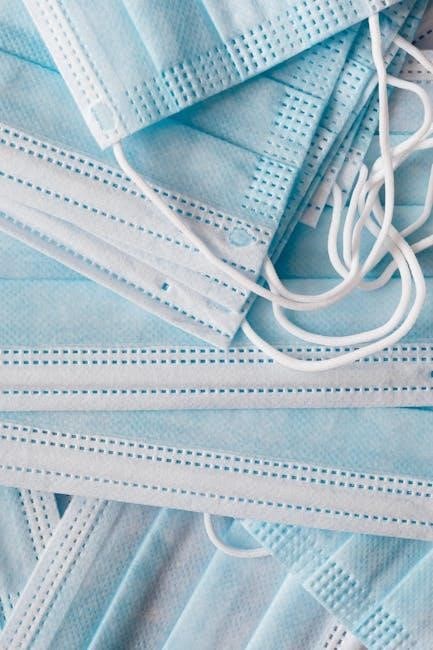ACTICOAT dressings are advanced wound care products designed to promote healing and prevent infection. These dressings utilize nanocrystalline silver technology to provide sustained antimicrobial action. Proper application and maintenance are crucial for optimal efficacy. This guide outlines the key steps and considerations for using ACTICOAT dressings effectively.
Overview of Acticoat Dressings
ACTICOAT dressings are advanced wound care products designed to manage partial and full-thickness wounds; They incorporate nanocrystalline silver (NCS) technology, which provides sustained antimicrobial action for up to 7 days. These dressings are suitable for various wound types, including burns, pressure ulcers, and diabetic ulcers. Their unique construction ensures effective antimicrobial barrier properties while maintaining a moist wound environment. ACTICOAT dressings are available in different forms, such as ACTICOAT, ACTICOAT 7, and ACTICOAT Flex, offering flexibility in wound management. They are highly effective against a broad spectrum of pathogens, making them a valuable tool in preventing infection and promoting wound healing. Proper use and maintenance are essential to maximize their benefits and ensure optimal patient outcomes.
Importance of Following Instructions for Use
Adhering to the instructions for using ACTICOAT dressings is critical for ensuring their effectiveness and safety; Proper application, maintenance, and removal techniques help maintain the dressing’s antimicrobial properties and promote wound healing. Deviating from the guidelines may lead to reduced efficacy or potential complications, such as skin irritation or delayed healing. Following the instructions also ensures the dressing remains moist, which is essential for its function. Additionally, correct usage minimizes the risk of infection and supports the overall wound care strategy. By carefully following the provided instructions, healthcare professionals can optimize patient outcomes and achieve the intended benefits of ACTICOAT dressings. Compliance with these guidelines is thus a cornerstone of effective wound management.
What is Acticoat?
ACTICOAT is an advanced wound dressing featuring nanocrystalline silver technology, designed for effective antimicrobial action and wound care management. It is specifically formulated to promote healing and prevent infection in various types of wounds.
Nanocrystalline Silver Technology
ACTICOAT dressings incorporate nanocrystalline silver (NCS) technology, which provides a sustained antimicrobial action. This unique construction allows the silver to be released in ionic form when exposed to moisture, effectively disrupting microbial DNA and enzymes. The nanocrystalline structure ensures a high surface area, enhancing the release of silver ions for prolonged antimicrobial activity. This technology is particularly effective against a broad spectrum of pathogens, including bacteria, fungi, and resistant strains like MRSA. The sustained release of silver ions helps maintain an antimicrobial environment for up to 7 days, depending on the dressing type. This makes NCS technology ideal for managing acute, chronic, and burn wounds, promoting wound healing while minimizing the risk of infection.
Purpose and Functionality
ACTICOAT dressings are designed to serve as antimicrobial barrier dressings for managing partial and full-thickness wounds. Their primary purpose is to reduce the risk of infection by leveraging the antimicrobial properties of nanocrystalline silver. The dressings are engineered to maintain a moist wound environment, which promotes healing while preventing microbial colonization. They are suitable for use on a variety of wounds, including burns, pressure ulcers, venous ulcers, and diabetic ulcers. ACTICOAT dressings are absorbent, making them ideal for wounds with moderate to high exudate. Their functionality extends to reducing the need for frequent dressing changes and minimizing the reliance on systemic antibiotics, thereby supporting wound care efficiency and patient comfort.

Types of Acticoat Dressings
ACTICOAT dressings are available in various forms, including ACTICOAT, ACTICOAT 7, ACTICOAT Flex 3, and ACTICOAT Flex 7, each designed for specific wound care needs and durability.
Acticoat Dressing
ACTICOAT Dressing is a premium wound care product featuring nanocrystalline silver (NCS) technology, providing sustained antimicrobial action for up to 7 days. Designed for partial and full thickness wounds, it effectively manages bioburden, reducing the risk of infection. The dressing is absorbent and acts as a barrier, making it suitable for burns, pressure ulcers, and diabetic ulcers. It is essential to keep the dressing moist but not soaking wet to avoid tissue maceration. Regular monitoring, every 2-3 hours, ensures optimal healing conditions. ACTICOAT Dressing is a versatile solution for promoting wound healing and preventing infection in various clinical settings.
Acticoat 7 Dressing
ACTICOAT 7 Dressing is an advanced antimicrobial wound care product designed for use on partial and full thickness wounds, including infected wounds managed per local clinical protocols. It features nanocrystalline silver technology, providing sustained antimicrobial action for up to 7 days. The dressing is absorbent and acts as a barrier, making it suitable for burns, pressure ulcers, diabetic ulcers, and graft sites. ACTICOAT 7 can be used to pack wounds and should be secured with a secondary dressing to maintain moisture. Regular monitoring is essential to ensure the dressing remains damp but not excessively wet, preventing tissue maceration. Its efficacy in managing wound bioburden can reduce the need for antibiotics, promoting faster healing and infection prevention.
Acticoat Flex 3 Dressing
ACTICOAT Flex 3 Dressing is a flexible, antimicrobial wound care product designed for partial and full thickness wounds. It utilizes nanocrystalline silver technology to provide sustained antimicrobial action for up to 3 days. The dressing is ideal for wounds requiring flexibility, such as those on joints or areas prone to movement. ACTICOAT Flex 3 is suitable for burns, pressure ulcers, and diabetic ulcers, and can be used to pack wounds. It should be kept moist but not overly wet to avoid tissue maceration. Regular monitoring is recommended to ensure optimal wound environment. The dressing is secured with an appropriate secondary dressing to maintain moisture and promote healing. Its antimicrobial properties help reduce the risk of infection, making it a versatile option for various wound types.
Acticoat Flex 7 Dressing
ACTICOAT Flex 7 Dressing is a highly flexible, antimicrobial wound care solution designed for partial and full thickness wounds. It incorporates nanocrystalline silver technology to deliver sustained antimicrobial action for up to 7 days. This dressing is particularly suitable for wounds requiring extended protection, such as burns, pressure ulcers, and diabetic ulcers. ACTICOAT Flex 7 can be used on infected wounds when managed according to local clinical protocols. It is designed to maintain a moist wound environment, promoting healing while reducing the risk of infection. The dressing should be secured with an appropriate secondary dressing to ensure it remains in place and retains moisture. Regular monitoring is essential to avoid over-saturation and tissue maceration, ensuring optimal wound care outcomes.

Indications for Use
ACTICOAT dressings are indicated for partial and full thickness wounds, including pressure ulcers, burns, diabetic ulcers, and graft sites. They act as an antimicrobial barrier dressing.
Partial Thickness Wounds
ACTICOAT dressings are effective for managing partial thickness wounds, which involve damage to the epidermis and dermis layers but not the entire skin thickness. These wounds, such as burns, venous ulcers, or diabetic ulcers, benefit from ACTICOAT’s antimicrobial properties, which help reduce bacterial load and promote a conducive environment for healing. The dressing’s nanocrystalline silver technology releases silver ions upon moisture contact, providing sustained antimicrobial action for up to seven days. This feature is particularly advantageous in partial thickness wounds, where the risk of infection is high. Proper application and maintenance, as outlined in the instructions, ensure optimal dressing performance and support the healing process effectively.
Full Thickness Wounds
ACTICOAT dressings are suitable for managing full thickness wounds, which extend through all layers of the skin and may involve subcutaneous tissue. These wounds, often resulting from severe burns, trauma, or diabetic ulcers, require advanced care to prevent infection and promote healing. ACTICOAT’s antimicrobial properties, delivered through nanocrystalline silver technology, are particularly beneficial in such cases, as they help reduce bacterial colonization and minimize the risk of infection. The dressing’s ability to maintain a moist wound environment further supports the healing process. Proper application and regular monitoring, as per the instructions, are essential to ensure the dressing’s effectiveness in managing full thickness wounds and facilitating optimal recovery outcomes. Adherence to these guidelines helps in achieving the best possible results for wound care.
Specific Wounds (Burns, Pressure Ulcers, etc.)
ACTICOAT dressings are highly effective for managing specific types of wounds, including burns, pressure ulcers, and diabetic ulcers. Burns benefit from the dressing’s antimicrobial properties, which help prevent infection and promote healing. Pressure ulcers, often challenging to treat due to prolonged pressure, respond well to ACTICOAT’s ability to maintain a moist environment and reduce bacterial colonization. The dressing is also suitable for diabetic ulcers, where infection risk is high. Its nanocrystalline silver technology provides sustained antimicrobial action, making it ideal for wounds with high bioburden. Regular monitoring and adherence to the instructions ensure optimal outcomes for these specific wound types, enhancing the healing process and reducing complications. Proper use of ACTICOAT can significantly improve wound care for these challenging conditions.

Application Instructions
Clean the wound area thoroughly before applying ACTICOAT. Gently place the dressing, ensuring full coverage. Secure with a secondary dressing and keep moist. Check every 2-3 hours.
Preparation for Application
Before applying ACTICOAT dressings, ensure the wound area is clean and free of debris. Remove any previous dressings and rinse the wound with sterile water. Pat the surrounding skin dry to prevent maceration. If the wound is heavily exuding, consider using an absorbent secondary dressing. Select a dressing size that fully covers the wound bed, ensuring a 1-2 cm margin around the wound edges. Gently remove the backing from the ACTICOAT dressing and place it directly on the wound. Smooth out any air pockets or wrinkles to ensure even contact. Keep the dressing moist but not soaking wet, as excessive moisture may lead to tissue maceration. Always follow the manufacturer’s guidelines for preparation and application.
Step-by-Step Application Process
Begin by washing your hands thoroughly. Clean and rinse the wound with sterile water to remove any debris or bacteria. Gently pat the surrounding skin dry. Peel the protective backing from the ACTICOAT dressing and place it directly over the wound, ensuring full coverage. Smooth the dressing to eliminate air pockets and wrinkles. For secure placement, use a secondary dressing to hold it in position. If the wound is deep or has uneven surfaces, fold the dressing as needed for proper fit. Keep the dressing moist by misting with sterile water if it becomes dry. Monitor the dressing regularly to ensure it remains intact and functional. Follow these steps carefully to promote healing and prevent infection.
Securing the Dressing
After placing the ACTICOAT dressing on the wound, secure it with a secondary dressing to ensure it remains in position. Use a breathable, absorbent material or a flexible bandage to cover and hold the dressing firmly but not overly tight. Avoid applying excessive pressure, which could restrict blood flow or cause discomfort. Ensure the edges of the secondary dressing are sealed properly to prevent the ACTICOAT from shifting or detaching. For wounds in high-friction areas, additional securing methods like hypoallergenic tape may be necessary. Regularly check the dressing to ensure it remains moist and securely in place, adjusting the secondary dressing as needed. Proper securing promotes healing and prevents complications.

Maintenance and Care
Keep the ACTICOAT dressing damp but not soaking wet. Monitor moisture levels regularly, ensuring the dressing remains hydrated to maintain its antimicrobial properties and promote healing. Avoid overdrying, as this can reduce effectiveness. If the dressing becomes dry, gently moisten it with sterile water. Regular checks help prevent complications and ensure optimal wound environment.
Keeping the Dressing Moist
Keeping the ACTICOAT dressing moist is crucial for its effectiveness. The dressing should remain damp but not soaking wet, as excess moisture can lead to tissue maceration. Check the dressing every 2-3 hours while awake to ensure it stays hydrated. If the dressing becomes dry, gently moisten it with sterile water, distilled water, or saline solution. Avoid using tap water, as it may contain impurities. Maintaining the right moisture level helps preserve the antimicrobial properties of the nanocrystalline silver and promotes a conducive environment for wound healing. Proper hydration also prevents the dressing from adhering to the wound bed, which can cause discomfort during removal. Regular monitoring ensures optimal conditions for recovery and prevents complications.
Monitoring the Dressing
Regular monitoring of the ACTICOAT dressing is essential to ensure its effectiveness and the wound’s progress. Check the dressing every 2-3 hours to confirm it remains moist but not overly saturated. Inspect for signs of maceration or dryness, adjusting hydration as needed. Additionally, monitor the wound for any indication of infection, such as increased redness, swelling, or foul odor. Proper observation helps maintain the antimicrobial barrier and promotes healing. Documenting these observations aids in tracking progress and making necessary adjustments to the treatment plan.
Ensure the dressing is securely in place and that no leakage or odor is present. If issues arise, consult the product’s instructions or seek professional guidance to address them promptly.

Removal Instructions
To remove ACTICOAT, inspect the dressing for saturation or loosening. Gently peel it away from the skin, taking care to avoid causing discomfort or damage. Use saline solution if necessary to assist in removal. After removal, inspect the wound and dressing for any remaining residue. Proper disposal and documentation of the process are recommended. If resistance is encountered, seek professional guidance to ensure safe and effective removal.
Step-by-Step Removal Process
Begin by washing your hands thoroughly to maintain sterility. Gently grasp the edge of the ACTICOAT dressing and slowly peel it away from the skin in one direction. Avoid pulling upwards to prevent skin irritation or injury. If the dressing adheres stubbornly, soak it with sterile saline solution for a few minutes to loosen it. Continue peeling carefully, ensuring minimal discomfort. Once removed, discard the dressing appropriately. Inspect the wound for any residual debris or signs of infection. Document the removal process and wound condition for future reference. If resistance or pain occurs, consult a healthcare professional for assistance.
Aftercare Following Removal
After removing the ACTICOAT dressing, inspect the wound for signs of healing or infection, such as redness, swelling, or pus. Wash the area with sterile saline solution to remove any residual debris. Pat the skin dry with a clean towel. If prescribed, apply an antimicrobial ointment to the wound. Cover the area with a sterile, non-adherent secondary dressing to protect it from further contamination. Monitor the wound for any changes and maintain a moist environment to promote healing. Schedule a follow-up appointment with a healthcare professional to assess progress. Proper aftercare ensures the wound remains clean, reducing the risk of infection and supporting the healing process effectively.
Benefits of Acticoat
ACTICOAT provides sustained antimicrobial action, reducing infection risks in various wounds. Its versatility and effectiveness make it a cost-efficient solution, minimizing antibiotic reliance.
Antimicrobial Action
ACTICOAT dressings leverage nanocrystalline silver (NCS) technology, delivering potent antimicrobial effects. This technology releases silver ions in a controlled manner, effectively targeting bacteria, fungi, and other pathogens. Unlike traditional silver dressings, NCS provides a sustained release, maintaining antimicrobial activity for up to seven days. This prolonged action helps prevent infection, promotes a clean wound environment, and supports tissue repair. The broad-spectrum efficacy of silver ensures that ACTICOAT is effective against a wide range of microorganisms, including antibiotic-resistant strains. This feature is particularly beneficial in managing chronic and acute wounds, burns, and infected sites. The antimicrobial properties of ACTICOAT contribute significantly to wound healing by minimizing bioburden and reducing the need for systemic antibiotics.
Cost-Effectiveness
ACTICOAT dressings are a cost-effective solution for wound management due to their extended antimicrobial activity and reduced need for frequent dressing changes. The sustained release of nanocrystalline silver allows for up to seven days of protection, minimizing the frequency of interventions and associated healthcare costs. By preventing infection and promoting faster healing, ACTICOAT reduces the overall expense of wound care. Its ability to manage bioburden effectively can also lower the reliance on antibiotics, further contributing to cost savings. This makes ACTICOAT a valuable option for healthcare systems aiming to optimize resource allocation while delivering high-quality patient care. The long-lasting properties of ACTICOAT ensure that it remains a financially viable choice for managing complex wounds.

Troubleshooting Common Issues
Addressing Common Problems
Common issues with ACTICOAT include dressing dryness or skin irritation. To address, remoisten with sterile water and monitor. Consult a healthcare provider if irritation persists for proper guidance.
Common issues with ACTICOAT dressings include dryness, skin irritation, or improper adhesion. If the dressing dries out, remoisten it with sterile or distilled water. For skin irritation, rinse the area with saline solution and reassess sensitivity. Ensure the dressing is secured properly to avoid shifting. Monitor for signs of infection, such as redness or pus, and consult a healthcare professional if they persist. Avoid using harsh cleansers, as they may disrupt the antimicrobial properties of the silver. Regularly inspect the dressing and surrounding skin to address issues early. Proper handling and adherence to instructions can minimize complications and ensure optimal wound healing outcomes. Always follow the manufacturer’s guidelines for troubleshooting and seek medical advice if concerns arise.
ACTICOAT dressings effectively promote wound healing through nanocrystalline silver technology, offering antimicrobial protection. Adhering to application and maintenance instructions is crucial for optimal outcomes and infection prevention.
ACTICOAT dressings are advanced wound care products utilizing nanocrystalline silver technology for sustained antimicrobial action. They are indicated for partial and full thickness wounds, including burns, pressure ulcers, and diabetic ulcers. Proper application, maintenance, and removal are essential to ensure effectiveness and prevent infection. The dressings should be kept moist but not soaked to avoid tissue maceration. Regular monitoring and adherence to instructions are critical for optimal healing outcomes. ACTICOAT dressings offer a cost-effective solution for managing wound bioburden, potentially reducing the need for antibiotics. Following the provided guidelines ensures the dressings perform as intended, promoting a conducive environment for wound recovery.
Importance of Adhering to Instructions
Adhering to the instructions for using ACTICOAT dressings is crucial for ensuring their effectiveness and safety. Proper application, maintenance, and removal techniques help prevent complications and promote optimal wound healing. Failure to follow guidelines may lead to reduced antimicrobial efficacy or increased risk of infection. Keeping the dressing moist, monitoring its condition, and securing it correctly are essential steps to avoid tissue maceration or dressing dislodgement. By following the recommended protocols, healthcare providers can maximize the dressings’ benefits, such as sustained antimicrobial action and absorption capabilities. Adherence to instructions also ensures patient comfort and supports the overall goal of achieving timely and effective wound recovery. Consistency in following the guidelines is key to achieving desired clinical outcomes.
References
Smith & Nephew Medical Ltd. ACTICOAT Instructions for Use. Croxley Park Building 5, Lakeside. Advanced Wound Management.
- ACTICOAT Dressing Product Booklet;
- Case Studies on Wound Care Protocols.
- Clinical Guidelines for Antimicrobial Dressings.
Sources of Information
The information provided is based on data from Smith & Nephew Medical Ltd., the manufacturer of ACTICOAT dressings. Additional details were sourced from clinical guidelines, product booklets, and wound care protocols. Key references include:
- ACTICOAT Instructions for Use (IFU) document by Smith & Nephew.
- Clinical studies highlighting the efficacy of nanocrystalline silver technology.
- Advanced Wound Management resources from Croxley Park Building 5, Lakeside.
- Case studies demonstrating the application and benefits of ACTICOAT dressings.
These sources ensure the information is accurate and aligned with current medical practices.
Further Reading and Resources
For comprehensive understanding, refer to the official ACTICOAT Instructions for Use document by Smith & Nephew. Additional resources include clinical guidelines on wound care, product booklets, and case studies. Visit the Smith & Nephew website for detailed product information and video tutorials. Peer-reviewed articles on nanocrystalline silver technology provide deeper insights into its antimicrobial properties. Wound care organizations and medical journals also offer evidence-based recommendations. For practical tips, explore nursing forums and wound care communities. These resources help healthcare professionals and patients optimize the use of ACTICOAT dressings for improved wound healing outcomes.
